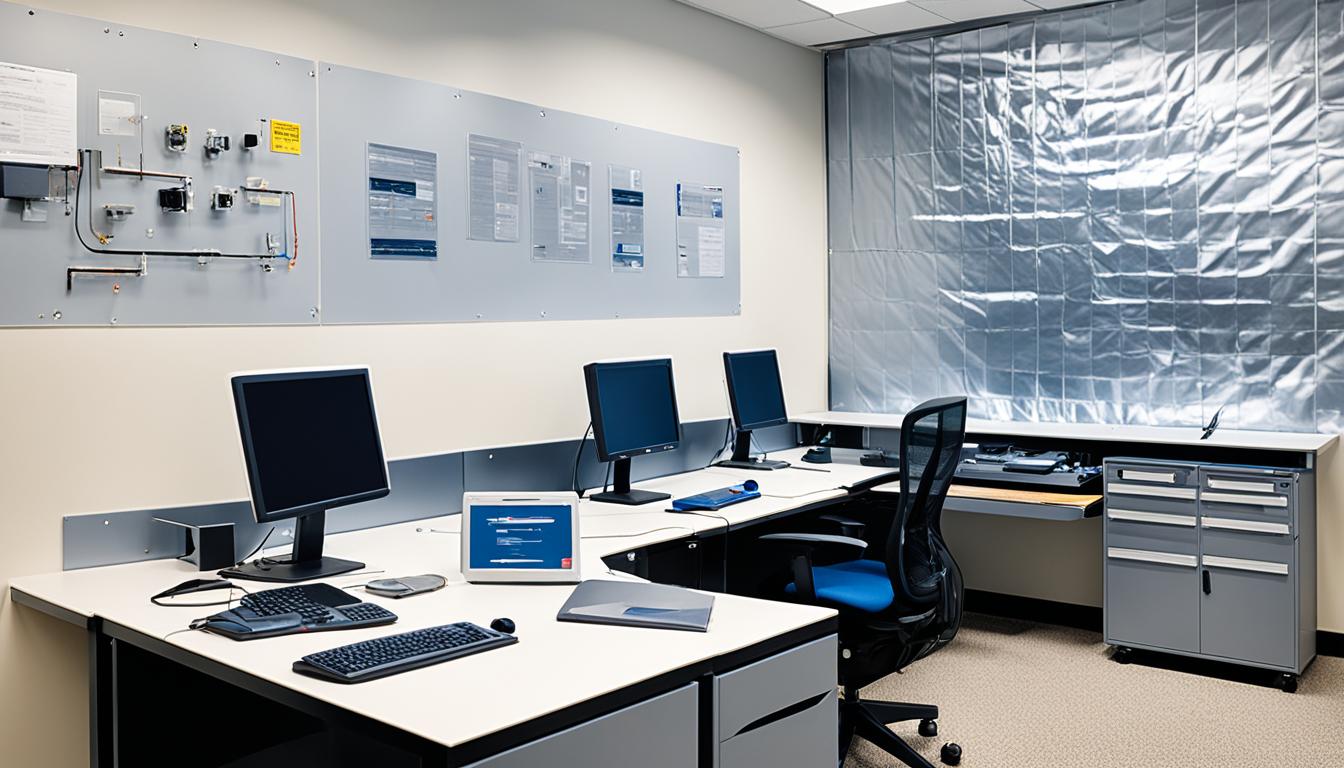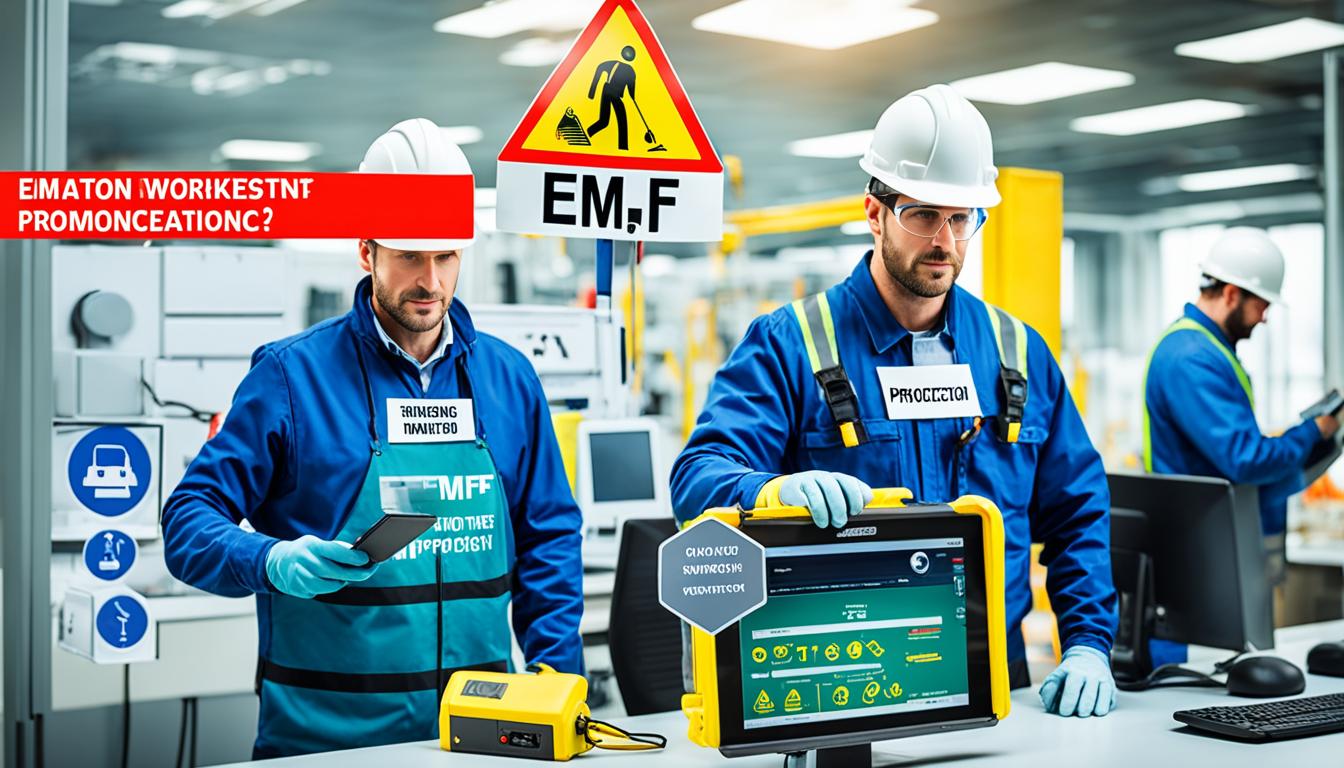Disclosure: This Post Contains Affiliate Links; We earn a commission on purchases.
Welcome to our article on managing workplace EMF exposure for employers. In today’s technologically advanced world, electromagnetic field (EMF) exposure is a concern that must be addressed in the workplace. Employers have a legal duty to manage and minimize the risks associated with EMF exposure, ensuring the safety and well-being of their employees. Let’s explore the important responsibilities that employers have in managing workplace EMF exposure and promoting EMF safety in the workplace.
Key Takeaways:
- Employers have a legal duty to manage and minimize the risks associated with workplace EMF exposure.
- Network operators and landlords must assess and limit EMF and RF exposure for employees, visitors, and passers-by.
- The Control of Electromagnetic Fields at Work Regulations 2016 outlines the requirements for organizations to adhere to.
- Employers should identify and understand the various sources of EMFs in the workplace.
- Protecting employees at a higher risk of EMF exposure is crucial.
Understanding EMF Sources in the Workplace
Employers play a critical role in managing workplace EMF exposure and ensuring the safety and well-being of their employees. To effectively address EMF risks, it is essential for employers to first understand the various sources of electromagnetic fields (EMFs) present in the workplace.
EMF sources can range from large transformers and current carrying conductors to electric motors and radio transmitting devices. Even everyday equipment such as computers and televisions can contribute to the overall EMF levels in the workplace.
Employers should conduct thorough assessments to identify and evaluate the exposure levels and potential risks associated with each EMF source. This assessment serves as the foundation for developing preventive measures to reduce EMF levels and minimize any potential health effects.
Implementing engineering controls is one approach employers can take to manage EMF risks. This may involve redesigning workspaces or implementing shielding measures to reduce EMF exposure. Providing personal protective equipment, such as EMF shielding garments or devices, can also offer additional protection to employees.
In addition to engineering controls, modifying work practices and procedures can also be effective in minimizing EMF exposure. Implementing rotation schedules, adjusting workstations, or relocating equipment can all help reduce EMF levels in specific areas of the workplace.
To ensure the success of workplace EMF risk management strategies, employers should cultivate a culture of awareness and education. By providing comprehensive training programs, employees can better understand the potential risks associated with EMF exposure and learn how to apply preventive measures in their daily work routines.
EMF Prevention Strategies
Below are some key strategies employers can implement to prevent and manage EMF exposure:
- Educate employees about the sources of EMFs in the workplace and their potential health effects.
- Encourage employees to follow proper work practices and guidelines to minimize EMF exposure.
- Implement engineering controls, such as shielding and equipment repositioning, to reduce EMF levels.
- Provide personal protective equipment, such as EMF shielding garments, to employees when necessary.
- Promote regular maintenance and inspection of equipment to ensure proper functioning and minimize EMF emissions.
- Encourage open communication between employees and management regarding EMF-related concerns and issues.
By understanding the sources of EMFs in the workplace and implementing effective prevention strategies, employers can create a safer and healthier work environment for their employees. Prioritizing workplace EMF risk management not only protects employees from potential health risks but also promotes productivity and well-being.
Protecting Employees at Risk of EMF Exposure
Certain employees in the workplace may be at a higher risk of electromagnetic field (EMF) exposure and require additional protection. This includes expectant mothers, employees with body-worn medical devices, those with passive or active implanted medical devices, and individuals with metal plates or artificial joints. It is crucial for employers to conduct specific risk assessments for these employees and take necessary precautions to minimize their exposure to EMFs.
Employers can implement various measures to protect at-risk employees from excessive EMF exposure. This may involve providing alternative work arrangements, such as modifying schedules or offering remote work options. Shielding measures, like using protective barriers or clothing, can also be implemented. Furthermore, employers may need to adjust the work environment to reduce EMF levels, such as relocating workstations or installing EMF-reducing equipment.
Regular monitoring and communication with at-risk employees are essential to ensure their safety. Employers should keep an open line of communication to address any concerns or questions employees may have regarding EMF exposure. Ongoing monitoring of EMF levels in the workplace can help identify potential risks and enable timely intervention.
The Importance of Protecting At-Risk Employees
Protecting at-risk employees from EMF exposure is crucial for several reasons:
- Health and well-being: By minimizing EMF exposure, employers can reduce the potential health risks to employees, ensuring their overall well-being and promoting a safe work environment.
- Legal compliance: Employers have a legal obligation to protect their employees from workplace hazards, including EMF exposure. Compliance with EMF safety guidelines and regulations is essential to avoid legal consequences.
- Employee satisfaction and retention: Prioritizing the safety and well-being of at-risk employees demonstrates a commitment to their welfare and can improve job satisfaction and retention rates.
“Protecting employees at risk of EMF exposure is not just a legal obligation, it is a moral responsibility. By implementing appropriate measures and providing a safe work environment, employers can safeguard their employees’ health and well-being.”
To further emphasize the importance of protecting at-risk employees, here’s a visual representation:
| Benefits of Protecting At-Risk Employees | |
|---|---|
| Health and well-being | Ensure employees’ overall well-being and promote a safe work environment |
| Legal compliance | Avoid legal consequences and comply with safety guidelines and regulations |
| Employee satisfaction and retention | Improve job satisfaction and retention rates |

By implementing these guidelines and measures, employers can protect at-risk employees and create a safe work environment with reduced EMF exposure.
Training and Education for EMF Awareness
Employers play a crucial role in managing workplace EMF exposure and ensuring the safety of their employees. Prioritizing training and education programs is essential to increase employee awareness of EMF hazards and promote safe working practices.
One effective way to enhance EMF awareness is by providing comprehensive EMF and RF training courses developed by trained professionals in the field. These courses cover a range of important topics, including the potential health effects of EMF exposure, how to identify EMF sources in the workplace, and the importance of following risk management protocols.
By equipping employees with the necessary knowledge and skills, employers empower them to protect themselves and minimize the risks associated with EMF exposure. Training programs can also contribute to creating a culture of safety and responsibility in the workplace.
“Education is the most powerful tool you can use to change the world.” – Nelson Mandela
With the right training, employees gain a better understanding of EMF safety practices and can actively contribute to implementing and maintaining effective risk management strategies. They become more proactive in identifying potential hazards and taking appropriate actions to mitigate EMF exposure risks.
Furthermore, training helps foster a sense of trust and confidence among employees, knowing that the company values their well-being and provides the necessary resources to ensure a safe working environment.
Benefits of Training and Education for EMF Awareness
Implementing comprehensive training and education programs for EMF awareness brings various benefits to employers and employees alike. Some of the key benefits include:
- Empowering employees to protect themselves from EMF exposure
- Reducing the likelihood of workplace accidents and health issues related to EMF exposure
- Fostering a culture of safety and responsibility
- Enhancing employee morale and job satisfaction
- Reducing the company’s liability and potential legal risks
The table below summarizes the benefits of training and education for EMF awareness:
| Benefits of Training and Education |
|---|
| Empowering employees to protect themselves from EMF exposure |
| Reducing the likelihood of workplace accidents and health issues related to EMF exposure |
| Fostering a culture of safety and responsibility |
| Enhancing employee morale and job satisfaction |
| Reducing the company’s liability and potential legal risks |
By investing in training and education, employers demonstrate their commitment to EMF safety in the workplace and prioritize the well-being of their employees.
Compliance with EMF Regulations and Guidelines
Employers have a legal obligation to comply with the EMF regulations and guidelines set forth by government authorities. This ensures the safety and well-being of employees and demonstrates a commitment to creating a safe and healthy work environment.
Compliance begins with conducting thorough EMF assessments to determine the levels of exposure in the workplace. These assessments help identify potential risks and enable employers to take appropriate measures to reduce and prevent EMF exposure. Implementing control measures, such as engineering controls or administrative controls, is crucial to ensure that exposure levels are below the set limits.
Regular monitoring of exposure levels, through exposure monitoring and risk assessments, is necessary to maintain compliance and ensure ongoing protection. Records of these assessments should be maintained to demonstrate adherence to the regulations and guidelines.
Staying updated with any changes or updates in EMF regulations is essential. Employers should proactively seek information from relevant government authorities and adjust their practices accordingly. By keeping up-to-date with the latest regulations, employers can ensure that their EMF safety protocols remain effective and compliant.
Benefits of Compliance
Complying with EMF regulations and guidelines offers numerous benefits to both employers and employees. First and foremost, it helps protect employees from potential health risks associated with EMF exposure. By ensuring that exposure levels are kept within safe limits, employers can safeguard the well-being of their workforce.
Additionally, compliance with regulations fosters trust and confidence among employees. It demonstrates that the employer takes their safety seriously and prioritizes creating a healthy work environment. This can lead to improved employee morale, increased productivity, and reduced absenteeism due to EMF-related health issues.
Furthermore, compliance with EMF regulations can help mitigate legal and financial risks. Non-compliance can result in penalties, fines, and legal action, which can be detrimental to the reputation and financial stability of an organization. By following the regulations and guidelines, employers can avoid these risks and ensure a smooth operation.

| Compliance Steps | Description |
|---|---|
| 1. Conduct EMF assessments | Determine exposure levels in the workplace and identify potential risks. |
| 2. Implement control measures | Take necessary actions to reduce and prevent EMF exposure, such as engineering controls or administrative controls. |
| 3. Monitor exposure levels | Regularly assess exposure levels through monitoring and risk assessments to ensure compliance. |
| 4. Maintain records | Keep detailed records of exposure monitoring and risk assessments to demonstrate compliance. |
| 5. Stay updated with regulations | Stay informed about any changes or updates in EMF regulations and adjust practices accordingly. |
Conclusion
Managing workplace EMF exposure is a crucial responsibility for employers. By understanding the sources of EMFs, protecting at-risk employees, and providing comprehensive training and education, employers can create a safe work environment and minimize the potential health risks associated with EMF exposure.
Compliance with EMF regulations and guidelines is essential for ensuring the well-being of employees and demonstrating a commitment to their health and safety. Employers should stay updated with any changes or updates in EMF regulations and adjust their practices accordingly.
Through proactive EMF risk management, employers can mitigate the risks and maintain a productive and healthy workforce. By prioritizing the implementation of preventive measures and equipping employees with the necessary knowledge and skills, employers can effectively manage workplace EMF exposure.
By adhering to the principles of workplace EMF safety and risk management, employers can create a culture of safety and protection, safeguarding the well-being of their employees and fulfilling their legal obligations.
Source Links
- https://www.intertek.com/blog/2019/02-28-emf/
- https://www.sor.org/getmedia/c83a4f3a-a56e-4c0a-9a3a-4fe3fd2317d8/hsg281.pdf
- https://praxis42.com/resources/emf-rf/emf-exposure/

Subscribe to Our Newsletter








